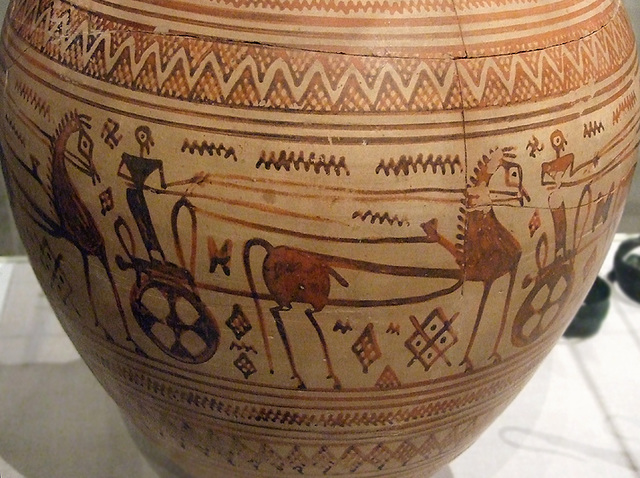Detail of the Mycenaean Terracotta Chariot Krater…
Detail of the Mycenaean Terracotta Chariot Krater…
Mycenaean Terracotta Chariot Krater in the Metropo…
Three Mycenaean Terracotta One-Handled Cups in the…
Three Mycenaean Terracotta Figurines in the Metrop…
Minoan Bull's Head Rhyton in the Metropolitan Muse…
Minoan Serpentine Blossom Bowl in the Metropolitan…
Cycladic Terracotta Kernos in the Metropolitan Mus…
Cycladic Terracotta Jug in the Metropolitan Museum…
Cycladic Marble Bowl in the Metropolitan Museum of…
Cycladic Harpist Figurine in the Metropolitan Muse…
Cycladic Harpist Figurine in the Metropolitan Muse…
Cycladic Female Figurine in the Metropolitan Museu…
Cycladic Marble Female Figurine in the Metropolita…
Cycladic Figurine in the Metropolitan Museum of Ar…
Marble Male Cycladic Figurine in the Metropolitan…
Upper Portion of a Female Cycladic Figurine in the…
Marble Female Figurine from the Cyclades in the Me…
Stirrup Jar with Octopus in the Metropolitan Museu…
Geometric Bronze Bracelet in the Metropolitan Muse…
Geometric Bronze Bird in the Metropolitan Museum o…
Bronze Mare and Foal in the Metropolitan Museum of…
Geometric Terracotta Krater in the Metropolitan Mu…
Detail from a Geometric Terracotta Krater in the M…
Geometric Terracotta Krater in the Metropolitan Mu…
Detail from a Geometric Terracotta Krater in the M…
Detail of a Greek Geometric Terracotta Krater Attr…
Detail of a Greek Geometric Terracotta Krater Attr…
Greek Geometric Terracotta Krater Attributed to th…
Greek Geometric Terracotta Krater Attributed to th…
Greek Geometric Terracotta Krater Attributed to th…
Greek Geometric Terracotta Krater Attributed to th…
Geometric Terracotta Krater in the Metropolitan Mu…
Terracotta Neck Amphora in the Metropolitan Museum…
Detail of the Neck of a Terracotta Neck Amphora in…
Unattributed Terracotta Neck-Amphora in the Metrop…
Unattributed Terracotta Neck-Amphora in the Metrop…
Unattributed Terracotta Neck-Amphora in the Metrop…
Detail of the Shoulder of an Unattributed Terracot…
Detail of Mourners on the Neck of an Unattributed…
Location
See also...
Keywords
Authorizations, license
-
Visible by: Everyone -
All rights reserved
-
417 visits
Detail of the Body of a Terracotta Neck Amphora in the Metropolitan Museum of Art, Oct. 2007


Neck amphora, fourth quarter of 8th century B.C.; Late Geometric
Greek, Attic
Terracotta; H. 27 in. (68.5 cm)
Rogers Fund, 1910 (10.210.7)
This tall wide-mouthed amphora represents the fully developed Geometric style and illustrates the profoundly significant shift of focus from abstract design to the human figure. Decorative bands, consisting of a zigzag, crosshatching, and dots, fill the area above and below the two main figural scenes. On each side of the amphora's neck is a warrior with a round shield poised between two horses; a long-legged bird stands beneath each horse. Five two-horse chariots with charioteers parade around the belly of the vessel. Each driver wears a long robe and holds four reins, signifying that two horses, not one, pull each chariot. Anatomical details of the warriors, charioteers, and horses have been reduced to simple geometric shapes. Characteristically, the heads are rendered in profile and the bodies in three-quarter view. Scattered lozenges, zigzags, and other shapes fill the background of both figural scenes. Snakes modeled in the round set off the lip, shoulder, and tall handles of the amphora.
Armed warriors, chariots, and horses are the most familiar iconography of the Geometric period. Whether these images reflect a real world of military threat and conflict, or refer to the heroic deeds of ancestors, is a longstanding debate in studies of Geometric art. Snakes, traditionally associated with death, probably refer to this amphora's function as a funerary dedication.
Text from: www.metmuseum.org/toah/hd/grge/ho_10.210.7.htm
Greek, Attic
Terracotta; H. 27 in. (68.5 cm)
Rogers Fund, 1910 (10.210.7)
This tall wide-mouthed amphora represents the fully developed Geometric style and illustrates the profoundly significant shift of focus from abstract design to the human figure. Decorative bands, consisting of a zigzag, crosshatching, and dots, fill the area above and below the two main figural scenes. On each side of the amphora's neck is a warrior with a round shield poised between two horses; a long-legged bird stands beneath each horse. Five two-horse chariots with charioteers parade around the belly of the vessel. Each driver wears a long robe and holds four reins, signifying that two horses, not one, pull each chariot. Anatomical details of the warriors, charioteers, and horses have been reduced to simple geometric shapes. Characteristically, the heads are rendered in profile and the bodies in three-quarter view. Scattered lozenges, zigzags, and other shapes fill the background of both figural scenes. Snakes modeled in the round set off the lip, shoulder, and tall handles of the amphora.
Armed warriors, chariots, and horses are the most familiar iconography of the Geometric period. Whether these images reflect a real world of military threat and conflict, or refer to the heroic deeds of ancestors, is a longstanding debate in studies of Geometric art. Snakes, traditionally associated with death, probably refer to this amphora's function as a funerary dedication.
Text from: www.metmuseum.org/toah/hd/grge/ho_10.210.7.htm
- Keyboard shortcuts:
Jump to top
RSS feed- Latest comments - Subscribe to the comment feeds of this photo
- ipernity © 2007-2024
- Help & Contact
|
Club news
|
About ipernity
|
History |
ipernity Club & Prices |
Guide of good conduct
Donate | Group guidelines | Privacy policy | Terms of use | Statutes | In memoria -
Facebook
Twitter

Sign-in to write a comment.